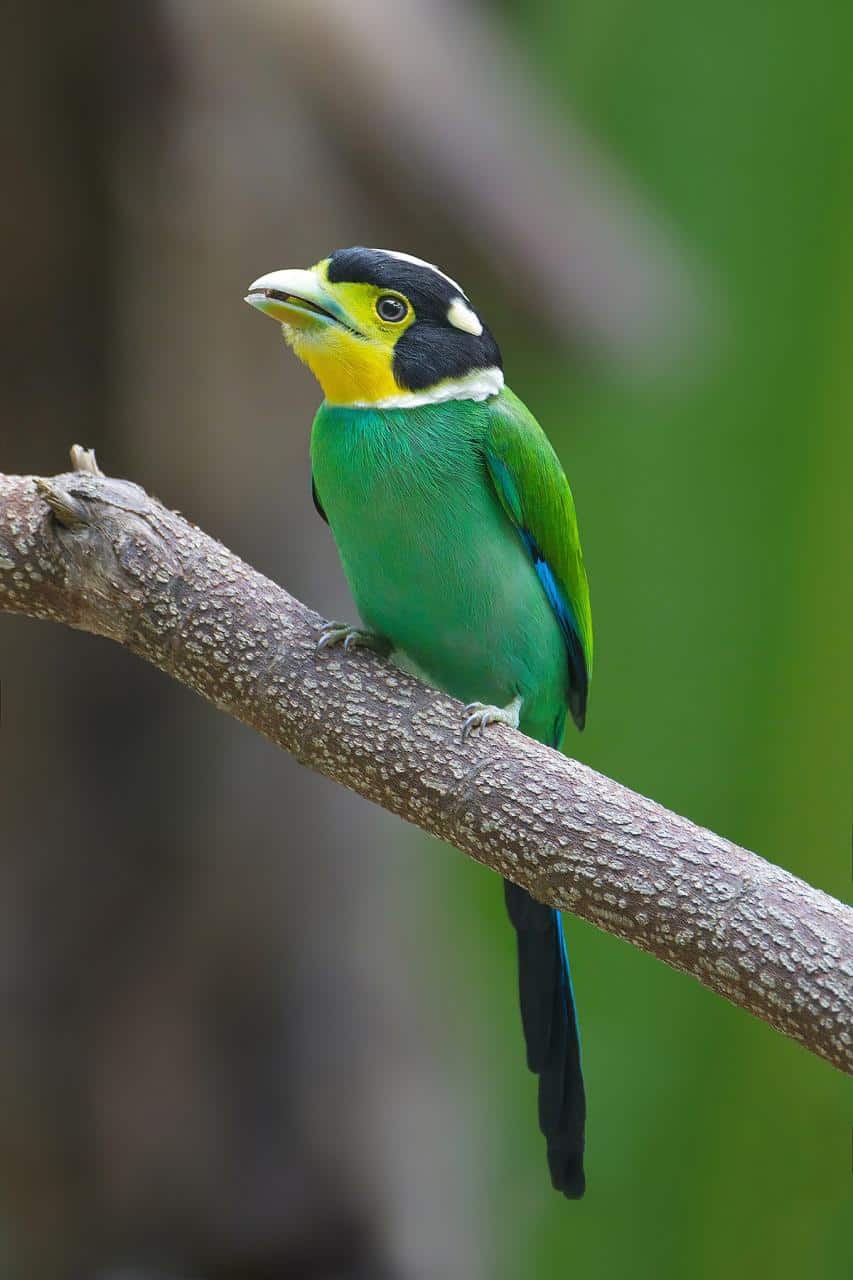Hummingbirds found in Arizona, USA
Hummingbirds found in the USA (by U.S. State) … Canada … Mexico … Puerto Rico … Jamaica … Honduras
Hummingbird Information … Hummingbird Species Photo Gallery
The following hummingbirds (with photos) are found in Arizona.
Most of the species that occur naturally in Arizona are restricted to southeastern Arizona.
Identification of many hummingbird species can often most easily be achieved by the males’ distinctive glossy throat patches, which range from orange, red, purple, green, blue. These bright patches may be restricted to only the throat or in some species may extend over the crown or even over most of the head. However, in poor light conditions, these color patches may simply look greyish/black, which makes identification more difficult. Even though females and juveniles of the different species often look alike, some physical clues can often be found.
Anna’s Hummingbirds, Calypte anna – Native and Common – Occur in the southeastern mountains (particularly Huachucas, Santa Ritas, Santa Catalinas, Mules) Some are year-round resident in the lower elevations of southern and central Arizona; while others are common visitors late summer through early fall. Rare in summer. Nests between January and June. Common in winter in Tucson and Phoenix and in desert scrub and riparian areas (near water).
One of the larger and the most vocal hummingbirds in the United States, where it is the only species to produce a song; specifically the males produce a complex series of scratchy noises, sounding like a sharp “chee-chee-chee; when moving from flower to flower, they emit toneless “chip” vocalizations. All other hummingbirds in the United States are mostly silent.
They are well known for their territorial behavior; the male makes elaborate dive displays at other birds and sometimes even at people. At the bottom of their dives, they produce high-pitched loud popping sounds with their tail feathers.
Males have glossy dark rose-red throats and crowns, which may appear black or dark purple in low light. The underside is mostly greyish; and the back metallic green.
Females have light grey chests with white and red spotting on the throat, greenish back and white tipped tails.
They resemble the Costa’s Hummingbirds, but the male’s Costa’s Hummingbird’s gorget (throat feathers) is longer than that of the Anna’s. They are larger than the Rufous Hummingbirds and lack the rusty coloration of the Rufous Hummingbirds.
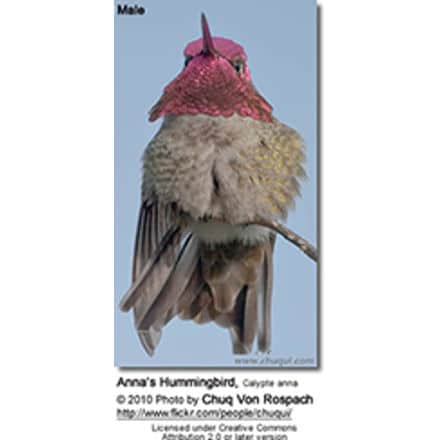
Black-chinned Hummingbirds (Archilochus alexandri) – Natives – Common to abundant between April through September in lower to middle elevations. They arrive in Arizona late spring (some as early as March) and leave in fall (early October) to winter in western and southern Mexico.
The male has a black, shimmering throat with a purple edge and pale feathers below that create a collar. However, unless the light is just right, the head looks all black. His back is green and there are some green feathers covering the chest.
The female is pale below (sometimes with a slightly speckled throat) and her back is green.
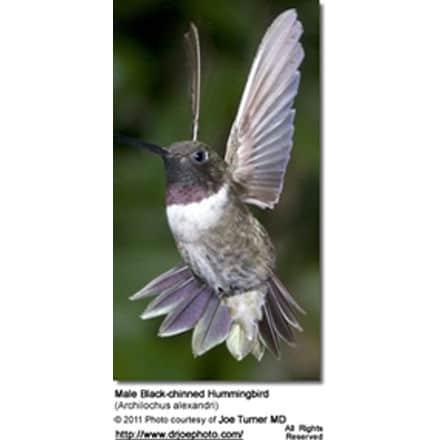
(Amazilia beryllina ssp. viola) – Native? Vagrants? Rare and local summer resident. Occur in the Ramsey Canyon, Miller Canyon, Cave Creek Canyon, Madera Canyon, Chiricahua National Monument (Chiricahua, Santa Rita, and Huachuca Mountains) of southeastern Arizona. Mostly found in pine-oak woodland and sycamore streamside forest in mountain canyons. They nest from July through September.
ID: They have shimmering green feathers from their bill to their rump, where the color changes to rufous and extends through their tail feathers.
The tail feathers have a shiny, iridescent purple tint that blends with the rufous color.
Males and females look alike.
Blue-throated Hummingbirds (Lampornis clemenciae) – Natives – Arrive in April and leave late October. In spring and summer locally common in Huachuca and Chiricahua Mountains, southeastern Arizona. Rare to uncommon elsewhere. Sighted in Cave Creek Canyon, Ramsey Canyon, and to a lesser extent in the Miller and Madera Canyons. They breed in late spring through summer; and most migrate south by October to winter in western Mexico. A few remain year-round in southeastern Arizona (around bird feeders).
The upper plumage is dull green, fading to a medium grey on the underside. It has white stripes behind the eyes and a narrower stripe extending backward from the corner of its relatively short bill, next to a blackish cheek patch.
The male can be identified by the iridescent blue throat patch (gorget), which may appear black or grey color in poor light.
The female and young have grey throats.
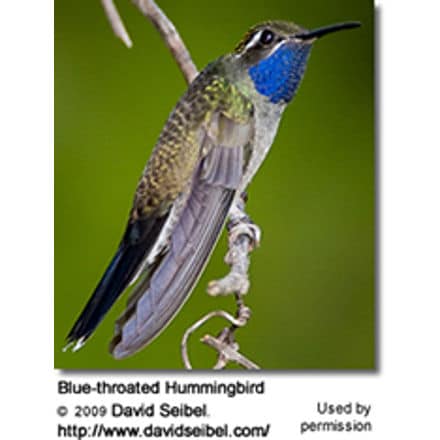
Broad-billed Hummingbirds (Cynanthus latirostris) – Natives – Arrive in late March or early April. Leave in September / October. Common spring and summer resident in drainages of Santa Cruz River (Patagonia, Nogales, Santa Rita Mountains), where they inhabit riparian woodlands and mesquite washes in southeastern Arizona. Uncommon in the Mule and Huachuca Mountains. In September / October, most migrate south to breed in western Mexico. A few are resident in Arizona, while others migrate east or west in fall.
The male is glossy green above and on the chest. He has a deep blue throat. His straight and slender beak is red with a black tip. His slightly forked tail is dark above, and the under tail feathers are white.
The female is less colorful than the male. Her throat, chest and belly are light to medium grey. She has a white stripe over each eye.

Broad-tailed Hummingbirds (Selasphorus platycercus) – Natives – Arrive late winter to early spring (~ March) to nest in southern Arizona. They usually depart in late September. They are uncommon to locally common in the southeastern “sky island” mountains (Chiricahuas, Huachucas, Santa Ritas, Santa Catalinas, Mules, Pinaleños). They are common in the north (Flagstaff, White Mountains).
Males can most easily be identified by their iridescent, rose-red throats, white chest feathers and metallic green back and crown and their rounded tails. The males’ tails make whistling noises in flight.
Females lack the flashy throat patch of the male and are mostly pale below. Their white-tipped outer tail feathers are rust-colored close to the body and blackish in the center; the tail feathers in the center range from green to blackish.

Costa’s Hummingbirds (Calypte costae) – Natives – Some are uncommon to locally common year-round residents in west and southwestern Arizona where they inhabit in desert scrub desert washes, and grassland where there are ocotillos (desert plants). Others are migratory, arriving in southeastern Arizona in February and leave late summer through early fall. Typically common in late winter and spring; but uncommon in winter in Tucson.
Males can easily be identified by the glossy purple crown and long, conspicuous throat feathers that project markedly down the side of the throats, giving it an elongated “moustache” appearance. The back is metallic green.
Females have greyish-green crowns (fop of the head) and backs. The chin and the plumage below are whitish, except for some black spotting on her throat. Her flanks are buffy-colored. She has a dark tail with white tips on the outer tail feathers.
They resemble the Anna’s Hummingbirds, but the male’s gorget (throat feathers) is longer than that of the Anna’s.
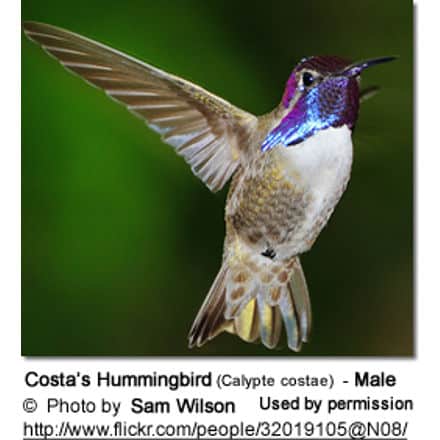
Magnificent or Refulgent Hummingbirds (Eugenes fulgens) – Native – Usually occur from late March to late October or early November. Occur in mountainous areas in eastern and southeastern Arizona. Uncommon to locally common in spring and summer in the higher mountains of southeastern Arizona (especially Chiricahuas, Huachucas, Santa Ritas). Uncommon to rare north of Mogollon Rim and east into western New Mexico. They arrive for the breeding season in late spring and migrate to winter in western Mexico by October. A few remain in southeastern Arizona year-round (near bird feeders).
They are nearly twice as large as any other hummingbird species found in this State, and can often be identified by their size alone.
The male has a metallic green throat and a black chest. His forehead and crown are purple and the back is dark green.
The female plumage is less bright. Her chest is solid grey. Her back and crown are olive green. Her tail feathers are pearl-grey tipped.
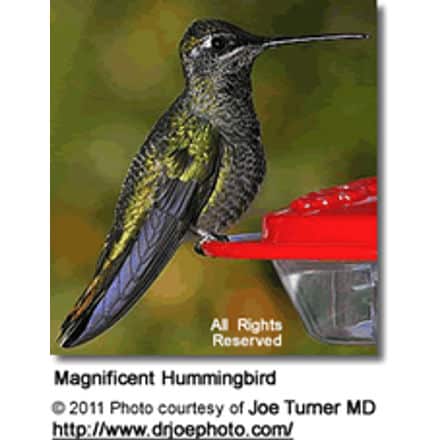
White-eared Hummingbirds (Basilinna leucotis) – Native – Mostly rare; but regular spring and summer residents in Huachuca Mountains (Miller Canyon, most often seen at Ramsey Canyon) in southeastern Arizona, where they inhabit riparian woodlands and pine-oak woodlands. They arrive late March to April for the breeding season and migrate south by October to winter in western Mexico.
ID: Both the male and female White-eared Hummingbird have a prominent white ear stripe (more boldly colored in the male) for which this species was named.
Lucifer Hummingbirds (Calothorax or Trochilus lucifer) – Native / Rare – These migratory birds arrive in March or early April for the breeding season and leave early fall (early October) to winter in western Mexico. They are most commonly sighted during the summer (breeding season) in Ash and Cave Creek Canyons; Huachuca, Chiricahua, Mule and Santa Rita Mountains, or near Portal, Arizona (located at the mouth of Cave Creek Canyon on the east side of the Chiricahua Mountains) in southeast Arizona – mostly at elevations of about 3,500–5,500 feet (~ 1,000 – 1,600 m). They are particularly common in agave-covered foothills.
ID: Its most distinctive features are the large head; long, thin and down-curved bill; small wings and small, tapered body. The tail is long, narrow and deeply forked, extending well beyond the wingtips. The forehead is green and the back is a drab grey-green. They have a pale buffy band across the chest. Both males and females have a white streak behind the eyes.
The male has a glossy magenta to blue-violet throat patch (gorget) that is elongated at the sides and is bordered white on both sides (note: the purple gorget looks black in poor light). The neck and the chest are white. The under plumage is whitish / greyish with greenish and rusty sides.
The female is larger in size, lacks the flashy throat patch of the male, and is light brown around the chest and throat area.

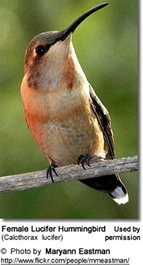
Bumblebee Hummingbirds (Atthis heloisa) – Accidental – only 2 specimens collected in the Huachuca Mountains (southeastern Arizona) in July 1896. There were no subsequent records.
The upper plumage and sides are mostly green. The plumage below is whitish. The rounded tail is green with a rufous base.
The male can be identified by the violet-red gorget (throat patch).
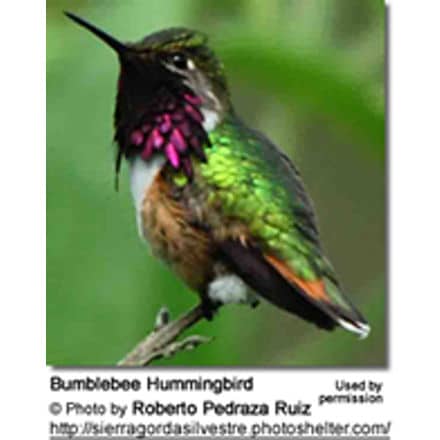
Calliope Hummingbirds (Stellula calliope) – Rare spring migrants (mostly through mountains) and uncommon to locally common fall migrant (at all elevations). They arrive in spring (sometimes as early as April) and leave by late summer (early September).
The smallest breeding bird in North America.
They are most easily confused with the Rufous Hummingbirds and the Broad-tailed Hummingbird.
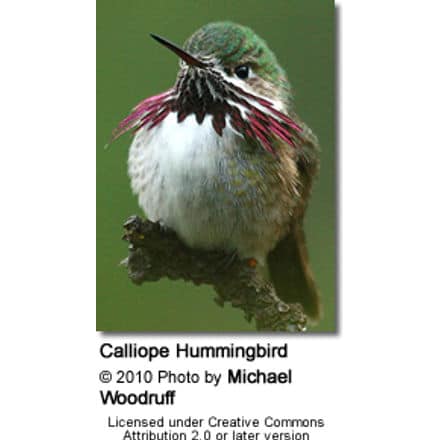
Violet-crowned Hummingbirds (Amazilia violiceps ssp. ellioti) – Rare / uncommon year-round residents, with breeding activities between July to September. Occur primarily in Mexico and southwestern to south central United States. In southeastern Arizona, they occur in the Madrean Sky Islands – enclaves of Madrean pine-oak woodlands found at higher elevations.
ID: This hummingbird is most easily identified by its white under plumage and iridescent bluish-violet crown (from where it gets its name). The back is emerald green. The tail is dark brown / olive green. The straight and very slender bill is reddish / orangey with a black tip.
Females and juvenile birds look similar to the males, but their plumage is generally less colorful than that of the male and they have a lighter and greener crown.
Ruby-throated Hummingbirds (Archilochus colubris) – Rare / Accidental – One adult female was recorded in 2005 (Tucson); and one adult male in the fall of 2007 and 2008 in Patagonia, southern Arizona.
The male has a ruby-red throat, a white collar, an emerald green back and a forked tail.
The female has a green back and tail feathers that are banded white, black and grey-green.
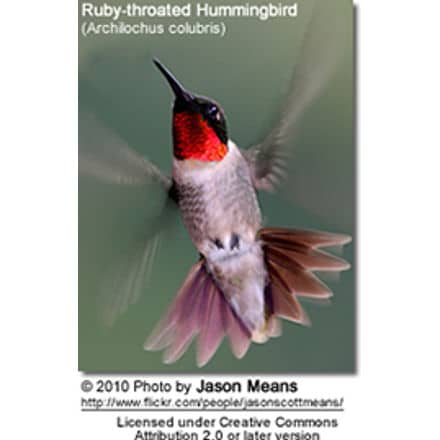
Rufous Hummingbirds (Selasphorus rufus) – Migrant only. Rare in winter and from March through April when it passes through especially in western Arizona. Common from July through mid-October when they pass through the entire state in large numbers.
These hummingbirds are usually found in gardens and at feeders. These birds are fearless, and are known for chasing away other hummingbirds and even larger birds, or rodents away from their favorite nectar feeders and flowers.
Males can easily be identified by their glossy orange-red throats.
Females have whitish, speckled throats, green backs and crowns, and rufous, white-tipped tail feathers.
Rufous Hummingbird versus the similar Ruby-throated Hummingbird (Identification)
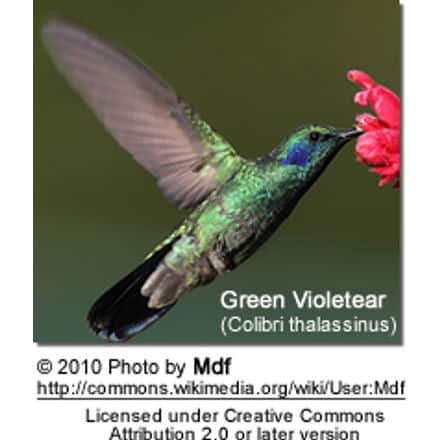
Allen’s Hummingbirds (Selasphorus sasin) – Rare / Accidental visitors during spring and fall migration and possibly during the winter. Most often seen July. Occur in southeastern Arizona (Patagonia, Madera Canyon, Miller Canyon). Rare in northern and central parts of Arizona. Historically, these birds nested in coastal California and wintered in Mexico; but more and more of them are remaining in California year-round or are traveling to the eastern United States for the winter.
They are almost impossible to distinguish from Rufous Hummer unless it is an adult male. The Allen’s can be identified by the green back whereas the adult Rufous has a coppery back.
The male has a throat that ranges in color from orange-red to yellow-orange, a back that is bright green, a rump that is rufous and its tail feathers are rufous tipped in black.
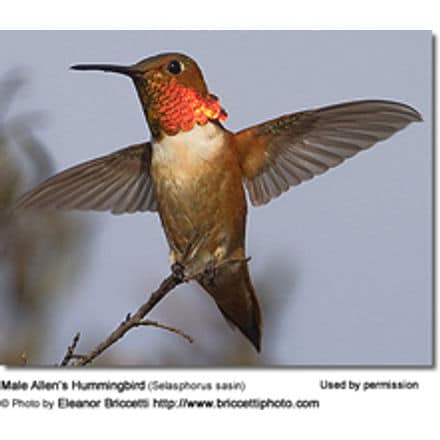
(Heliomaster constantii) – Very rare visitors. These Mexico / Central American natives occasionally visit the United States at the end of the breeding season – mostly in late summer and early fall. Sighted in the Madrean sky islands of the Sierra Madre ranges (Chiracahua and Huachuca Mountains) in southeastern Arizona, particularly in agave-covered foothills. It is not present every year. It is not present in the United States every year.
Key ID: Larger in size than most other hummingbirds in the area with a very long bill.
Males and females have a dark, mostly metallic bronze upper plumage (crown, back and tail) with a white patch on the back and rump (lower back – above tail). The plumage below is greyish white. They have a dark eye-stripe with a white stripe above and below.
The male has a metallic violet-red gorget (throat patch) that can look dull blackish in poor light conditions.
The female’s plumage is slightly less colorful and she lacks the throat patch of the male.
(Amazilia rutila) – Extremely rare and accidental – Only one summer record from Patagonia in southern Arizona.
ID: This medium-sized hummingbird is bronze green above and cinnamon-colored below. The square tail is reddish with gold and green edging. The long, slim bill has a black tip.
Is it a Hummingbird or an Insect?
The Hawk Moths (often referred to as “Hummingbird Moth”) is easily confused with hummingbirds, as they have similar feeding and swift flight patterns. These moths also hover in midair while they feed on nectar.
Moths have a couple of sensors or “antennas” on top of the head, which are key identifiers.



